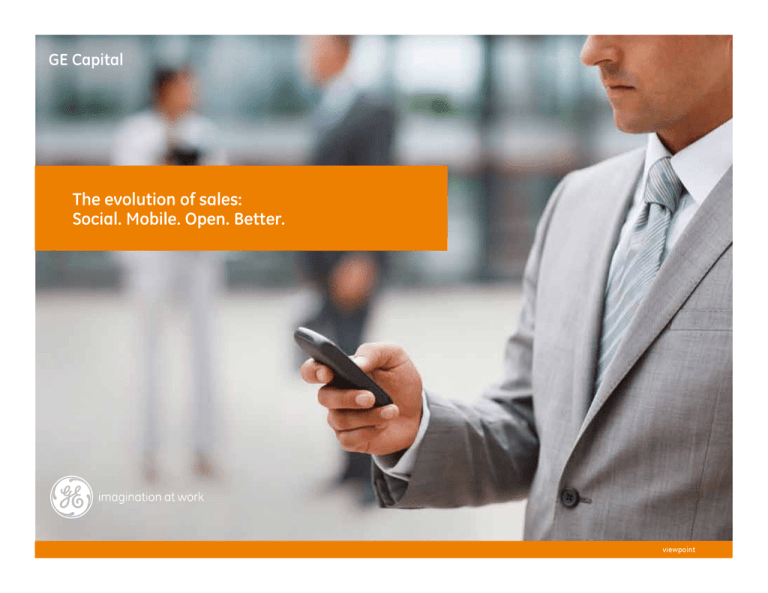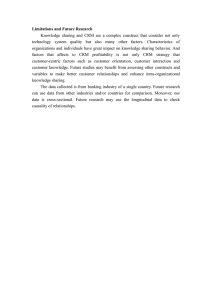
GE Capital
The evolution of sales:
Social. Mobile. Open. Better.
viewpoint
GE Capital
The evolution of sales: Social. Mobile. Open. Better.
Three years ago we went through a complete transformation in the way we approached sales. At GE, we did two things
at the same time—we upped the bar on what we demanded of our sales team in terms of experience and specialization,
and we significantly invested in and advanced the capabilities of our CRM system. These two separate movements came
together to create what we now term Sales 3.0.
First of all, we decided that we had to offer our clients
credible opinions on their business, particularly
because so many were being hit by the recession.
We simply had to bring them valuable solutions or we
weren’t helping them. As a result, we knew our sales
force needed to become far more specialized—this was
no longer a relationship business built around playing
golf. This shift required incredible change management.
It meant that we either trained our existing sales force
or hired a different type of salesperson—both of which
we ended up doing.
The evolution of sales: Social. Mobile. Open. Better.
At the same time that we were shaping this change
in our people, a separate movement in the firm had
been working for seven years to gather the data and
modeling capabilities to make the technology arm of the
sales process far more robust. During this process we
implemented a very advanced CRM system, knowing our
salespeople needed to be constantly armed with analytical
data and useful information to build relationships.
We converged the two movements. The new tools
created a new openness: an ability for our team
members to interact, make decisions and share in a
way they never had before. Instead of an individual
effort, sales became very tied together—very much a
group effort—and customer relationships flourished.
New technology and more
specialized salespeople significantly
up the quality of deals.
viewpoint
2
GE Capital
.
.
• Single View of One Client
• Account Prioritization
• Pipeline Reports
•
•
•
•
The tools that are needed to do the job well
.
Marketing ROI
Content Management
Segmentation & Coverage
Potentialization, Budgeting
& Analytics
• Cross-Sell
•
•
•
•
•
Mobile Enterprise
Client Community Tools
Social Networks
Frontier Curve
Enterprise Deal Selling
Sales as a social enterprise
To take sales to this level requires a tremendous amount of transparency and account sharing, both of which are new
to the more traditional sales organization that operates in silos and keeps information close to the vest. Sales 3.0 also
means that everything happens in real time: insights, debate, decisions, and strategic direction changes. As a result,
the speed of the movement of information and the flow of ideas create an ever-increasing ability to act more quickly.
Sales 3.0 naturally creates a flattening of the sales organization, whereby information on clients, on the markets,
on potential targets and on deals is available to everyone. Our sales representatives need to have an affinity for
technology, a willingness to be open and collaborative in their approach to sales, and
an ability to use the intelligence that technology offers them to create compelling ideas
and solutions that will provide value for their clients. They also need to be specialists
who can offer unique solutions.
The technology, as well as the more specialized and sophisticated salespeople we
have hired and trained, has significantly upped the quality of the deals. No longer are
we focused on the numbers; instead, we are walking side-by-side with our customers,
listening to them and presenting constructive thinking about how they can become
more profitable. The actual selling process takes longer, but is infinitely more productive
for our clients and for GE.
The evolution of sales: Social. Mobile. Open. Better.
GE’s CRM system is predicated on advanced analytics:
We have models that create peripheral vision and
models that create scenario planning. We have real-time
monitoring of our sales force’s prospecting activities,
and learning models with simulations for our teams to
remain current. For instance, we can immediately tell
which clients are conducting capital investments in
the form of buying versus those that are leasing. With
scenario planning, a CRM system can tell a salesperson
what circumstances will create a particular financing
opportunity in a certain time frame.
The CRM system also creates many new touchpoints.
One of the most basic is a connection through the
e-mail system. For example, if we create an e-mail
.
.
Capabilities
Because of our advanced CRM systems, our sales teams and business
management have 360-degree visibility into accounts and the market, a full
understanding of clients’ issues, up-to-the-minute information on events that may
affect clients, transparency about deals being made, and the ability to go to market
as one entity, where the “right hand” is working precisely in tandem with the “left hand”
so that the client always has clarity.
An effective CRM system is at the heart of this nextgeneration sales organization. It is all about getting
information from rich sources of data, and using this
information to inform the sales process.
.
•
•
•
•
•
One View of the Client
Account Prioritization
Accurate Pipeline
Accurate Account Assignments
Useful Operational Reporting
• Marketing Workflow:
Request, Track, Volume
• Marketing ROI:
Attach, Win/Loss, Trend
• Content Management:
Publish, Track, Version, Rate
• Market Coverage:
Meetings, Contacts
• Market Segmentation
• Potentialization & Budgeting
• Cross-Divisional Sales
• Automated SIC
• Analytical Tools (SAS)
• Mobile Enterprise
• Internal Social Network
• External Social Graph:
Company SG, Penetration
• External Client Communities
• Frontier Curves & AE Productivity
• Interface to Inventory Systems
• Enterprise Selling
• Same Meeting Deal Closure
Exhibit 1. Sales 3.0 is characterized by the rapid mobile and social access to customer information
(Source: GE)
viewpoint
3
GE Capital
Platforms
Dedicated platform consistent across region:
Operational reporting & One View of the Client: Pipeline, budget, account, record, sales stages
Content management: Marketing, attachment to ops, version control, rating, sharing
Social: Networks, social graph, contacts
Dedicated application or tool: Real-time and transparent reporting
Defined plan
Plan addresses culture and behavior desired
Plan administered by HR on quarterly basis
Dedicated CDW built and accounts mapped
Hierarchy defined
MDM team in place, process designed with workflow – control of new account and contact process
Data maps and dictionary
Exhibit 2. Sales 3.0 is supported by comprehensive customer relationship management, a sales incentive compensation plan, and advanced
data analysis (Source: GE)
campaign to invite clients to an information-sharing
event, the company receives an instantaneous RSVP.
The sales team can immediately identify who accepted
and who did not. Both create good reasons to speak
with clients. A call that says, “Great, I saw you accepted
and I will see you there,” is as effective as a call that
says, “I saw you can’t make it, but I will brief you on
what will be offered.”
Our sales teams can review, on a daily basis, their
customers’ financials, news, and analyst reports, all in
one place. They can read daily/weekly feeds on their
customers from sources such as Bloomberg, Reuters LPC
and OneSource. This allows sales representatives to get to
deals sooner by offering their customers an early read on
a potential financial opportunity or by flagging upcoming
financing events (such as mature debt, recent company
acquisitions, etc.).
The evolution of sales: Social. Mobile. Open. Better.
Raising the bar
While the CRM system, and the integrity of its data,
helps us harness information today in a way that is truly
transformative, this transformation also allows for new
conversations to happen. It creates insight and dialogue.
For instance, managers can see when a deal is lost,
and they can ask their team why it happened. They
can then aggregate that information and figure out
ways to turn it into a win, and spread that information
across the sales force. Management can also see
where their sales force is “hunting” and winning a lot.
They can take that winning knowledge and spread the
best practices throughout the organization, raising the
bar and the effectiveness of everyone. Headquarters
can also measure attributes of the pipeline: the deals,
their size, how much is moving through the stages of
sales and at what velocity, pricing and figure elasticity
curves, and price volume curves. This information
drives a culture of dialogue and a culture of change.
The sales force comes in from each and every
meeting and records how the meeting went with a
particular client. They “talk” about the personalities
they encountered and the challenges as well as the
prospects in developing a relationship. They share what
they’ve learned about a customer’s key issues, and
they can work together to build solutions. They form
groups and offer posts, in many ways like an internal
version of Facebook. Often the solutions that are
discussed and created extend beyond one client, and
have a lasting impact on many clients. The entire sales
team is, in this way, involved in developing ongoing and
advanced solutions that are likely to drive customer
profitability, share of wallet and retention across all the
relationships a company builds. And while collaboration
is enhanced, the CRM safeguards the institutional
memory of the account.
The inevitable movement
We believe this transformation in sales is inevitable for
most organizations. The technology that is available
today is so radically different—so unbelievably
effective—that it is creating what one of our team
members called “bionic” salespeople. The information
they are given, coupled with the training they receive
to understand that information and find ways to meet
unmet needs, has created a sales force that is far more
effective than they ever were. Our clients are benefiting
in ways they never could before, and we are benefiting
by offering our clients our insights and our knowledge.
Basically, it’s a win-win for everyone involved.
viewpoint
4
GE Capital
Contributors
GE Capital Commercial Excellence Team:
Eric Dusch
Tim Hyland
Christopher Johnson
John Sabino
GE Capital (NYSE: GE) works on things that matter. GE Capital
offers businesses and consumers around the globe an array
of financial products and services. Providing more than
money, GE Capital brings insight, knowledge and expertise
to every loan and lease. Not just banking. Building.
For more information, visit www.gecapital.com or follow
company news via Twitter (@GECapital).
Copyright © 2012 General Electric Capital Corporation. All rights reserved.
This publication provides general information and should not be used or taken as
business, financial, tax, accounting, legal or other advice. It has been prepared without
regard to the circumstances and objectives of anyone who may review it; therefore,
you should not rely on this publication in place of expert advice or the exercise of your
independent judgment. The views expressed in this publication reflect those of the authors
and contributors and not necessarily the views of General Electric Capital Corporation
or any of its affiliates (together, “GE”). GE does not guarantee that the information
contained in this publication is reliable, accurate, complete or current, and GE assumes
no responsibility to update or amend the publication. GE makes no representation
or warranties of any kind whatsoever regarding the contents of this publication, and
accepts no liability of any kind for any loss or harm arising from the use of the information
contained in this publication.
“GE,” “General Electric Company,” “General Electric,” “General Electric Capital Corporation,”
the GE Logo, and various other marks and logos used in this publication are registered
trademarks, trade names and service marks of General Electric Company. You may
not use, reproduce, or redistribute this publication, any part of this publication, or any
trademark or trade name without the written permission of GE.
The evolution of sales: Social. Mobile. Open. Better.
viewpoint
5


